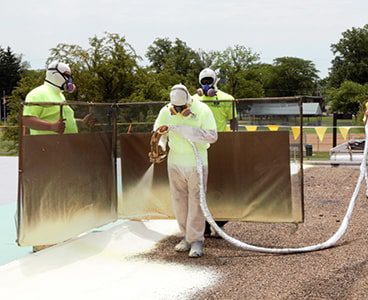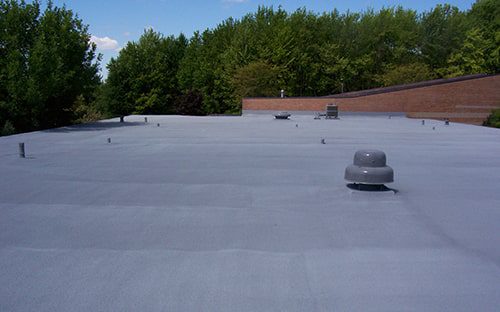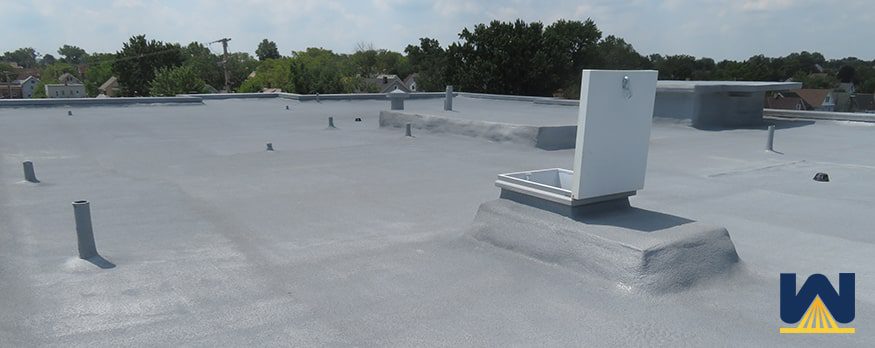Summary: Spray foam roofs are cost-effective for schools because they can avoid a complete tear-off by installing spray foam right over the existing roof. Spray foam also has the best R-value per inch of thickness of any roofing insulation. Spray foam roofing can be installed very quickly. Spray foam roofing can be renewed over and over again, making the lifetime cost much lower than traditional roofing systems.
So, you work for a school district and some of the roofs are leaking. You think, maybe it’s time to start getting quotes to remove and replace these 20-year-old roofs.
When you get quotes that include tearing off the entire roof, you might be blown away at the price.
So why not consider a non-traditional roofing system that doesn’t require a complete tear-off?
Don’t worry, when we say non-traditional, it doesn’t mean you’d be the first school to install a spray foam roofing system.
In fact, since 1979, West Roofing Systems has installed and maintained spray foam roofs over 100 different schools.
The reasons they chose spray foam:
- It avoids the complete tear-off
- It has the best R-value
- It’s installed quickly
- It has the lowest lifetime costs
Let’s get started.
Reason #1 – They avoid the complete tear-off

It’s very expensive to remove 100% of a roof and transport all those materials to a landfill.
A spray foam roof can avoid this because it can be installed right over the top of an existing roof system.
The only areas that are removed and replaced are the areas where wet insulation is present.
A contractor identifies these areas through a visual inspection, pulling core samples, and/or performing an infrared inspection.
In most cases, a spray foam roofing contractor only needs to remove 5-15% of the existing roof before installation.
Removing 5% of a roof versus removing 100% is a big difference in cost.
Why is avoiding a tear-off important for a school?
Schools have budgets just like any other entity. Any chance that they can get a high-performing roof for less means they can increase the funds of other well-needed areas.
Reason #2 – Spray foam has the best R-value
If you’re unaware of R-value, it’s “the capacity of an insulating material to resist heat flow. The higher the R-value, the greater the insulating power.”
Spray foam has an R-value of 6.5 per inch of thickness, which is more than any other roofing insulation out there:
- Spray Polyurethane Foam: 6.5 per inch
- XPS Insulation: 5.0 per inch
- EPS Insulation: 3.85 per inch
- Polyiso: 5.5 per inch
The more R-value your school’s roof has, the better it will keep the heat/cool inside of the school, which lowers your energy costs.
Depending on the current condition of the school’s roof, the reduction in energy bills can be very high, as was the case for Texas A&M University.
Texas A&M reduced the cost of their energy bills so much that the savings they saw paid for the cost of the spray foam installation in 4.5 years!
Why is R-value important for a school?
Schools are large facilities that spend lots of money keeping the building at a comfortable temperature for a large number of people. Energy is expensive. Any lowering of costs means the resources can be spent elsewhere.
Reason #3 – Spray foam can be installed quickly
Everyone wants projects and tasks completed as fast as possible.
Need an oil change, you want it done fast.
Have you ever been frustrated in the fast-food line…I’m sure you have?
The speed of installation matters when your school is getting a new roof system.
You don’t want the company cars, workers on the premises, and all the extra noise on your roof all summer long.
Since spray foam roofing is fluid-applied, it can be installed very quickly.
On a great weather day (no rain and limited wind), a spray foam contractor can install around 8,000-10,000 sq. ft. of spray foam roofing per day.
In most cases, this speed is about twice as fast as traditional roofing systems such as single-ply or metal.
Why is speed important for a school?
Summer is where most roofing projects get taken care of, which is only so long.
Reason #4 – Spray foam roofs have low lifetime costs
Unlike traditional roofing systems, once their projected lifetime is over, a spray foam roof can be renewed.
Let’s explain what a recoat/renewal is.
Say you get a spray foam roof installed in the Summer of 2021. Your new spray foam roof came with a 10-year warranty, which means that 20 mils of coating will be installed over the spray foam roof.
Now, it’s the year 2031, Tesla is the new Ford and Bitcoin has eliminated the paper dollar.
Also, the coating that protects your school’s SPF roof has worn down from 20 mils to 7-8 mils.
What happens is a “recoat”, which means the contractor will clean the roof and install a fresh layer of coating to bring the millage back to 20.
A new 10-year warranty would be granted, and the process can repeat over and over again.
A recoat costs 1/2 to 1/3 of the original cost of installation. To install a traditional roofing system after its lifetime is over, it would cost 100% of the original cost of installation.
Why is lifetime cost important for a school?
Schools normally stay around for a long time. Schools have an advantage over other businesses that often close after a few years. Being around for decades and decades should allow schools to think more long-term. Getting the cheapest option today might not be cost-effective over the lifetime of the building.
Now that you’ve learned how spray foam makes sense financially for school districts, let’s look at a case study.
Case Study: A School re-roofed with spray polyurethane foam
Please see the case study of Berea School District:
Case study: Berea School District

Project Size: 522,595 sq. ft. over 11 buildings
Roofing System: Spray foam over existing BUR and EPDM membranes
Project Duration: 8 weeks
Want to learn more about spray foam roofing?
Here are our most popular articles on spray foam roofing:
- How much does a spray foam roof usually cost?
- What common problems do spray foam roofs have?
- Masterbolt – a review of a spray foam roofing project


